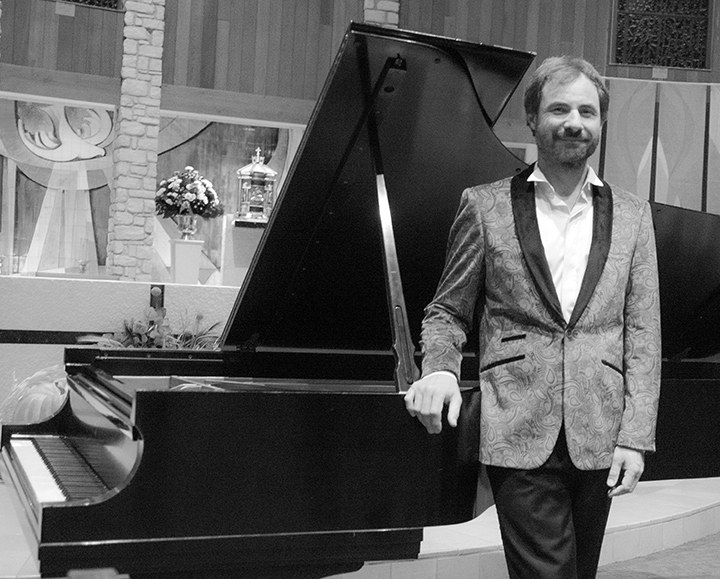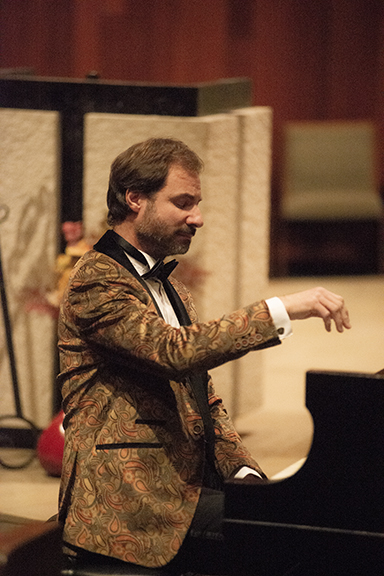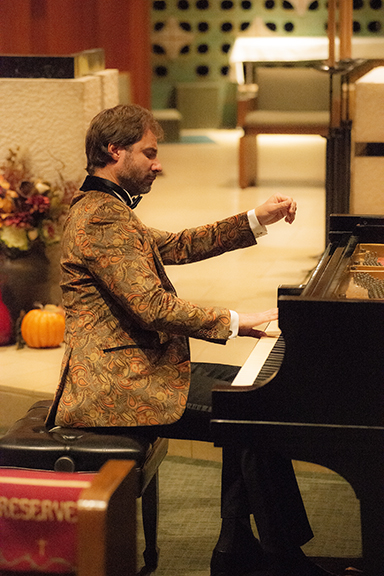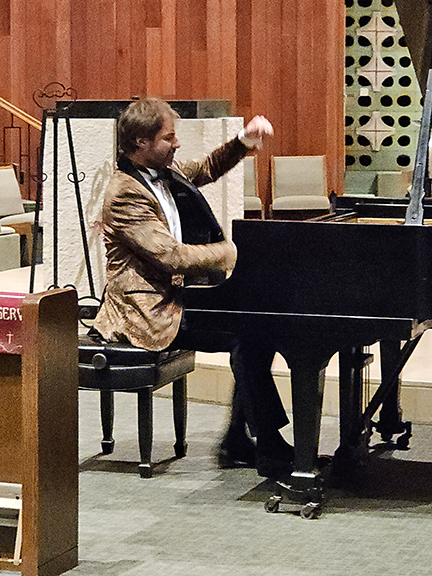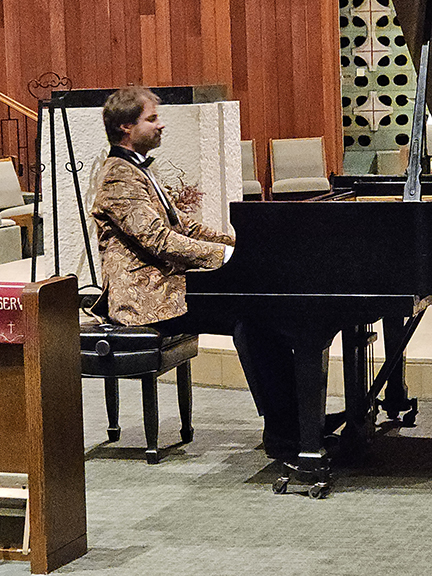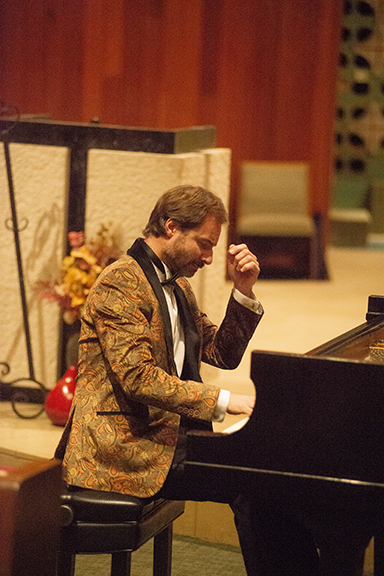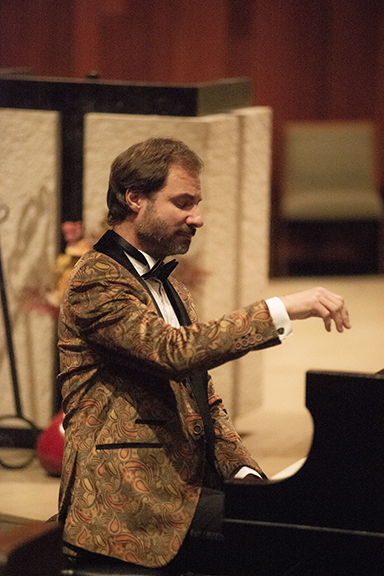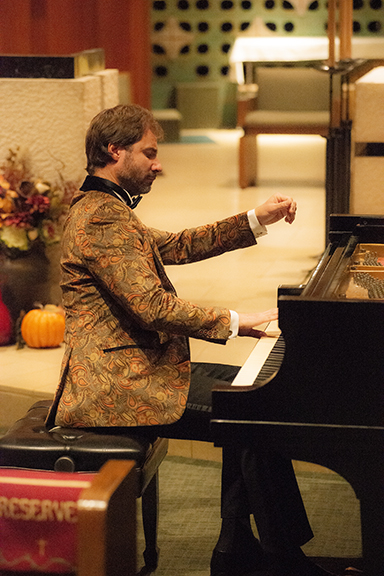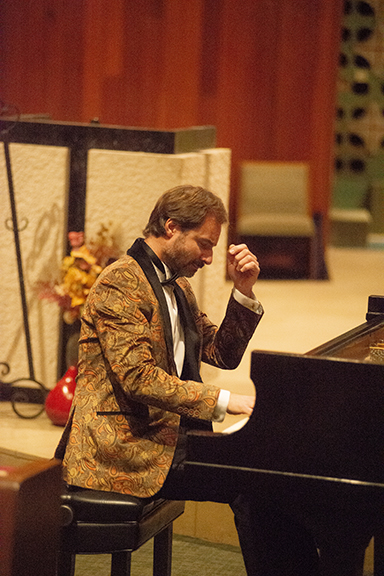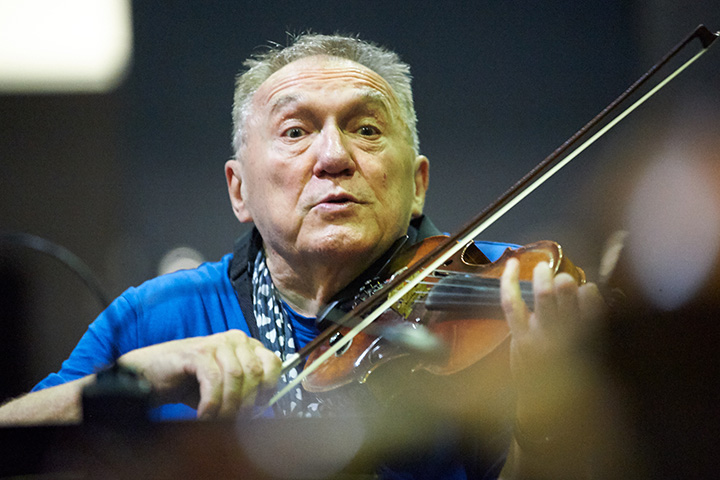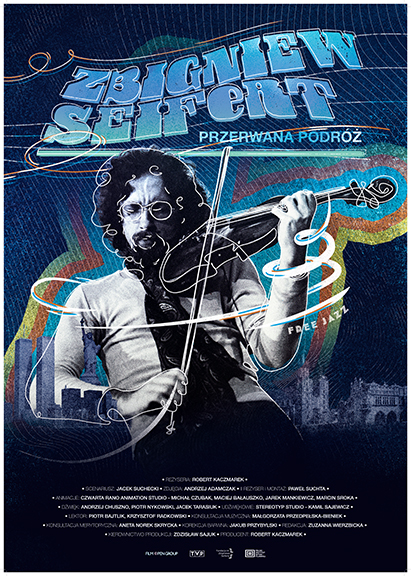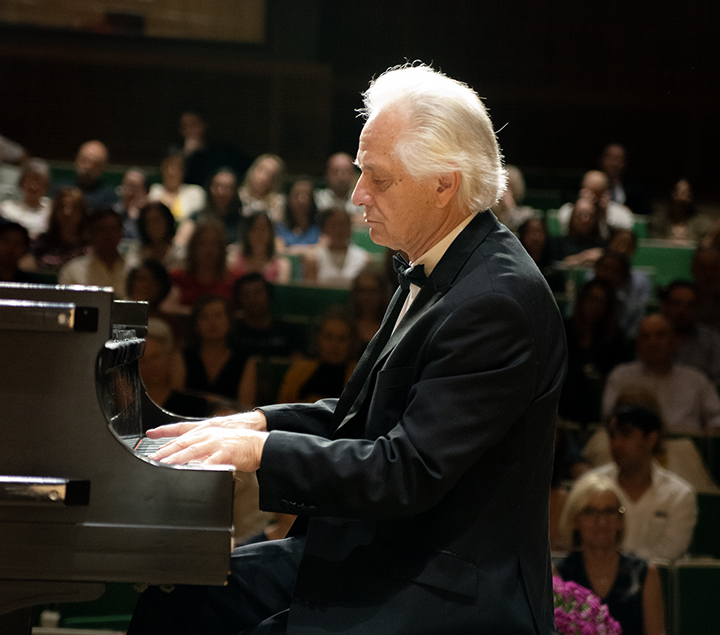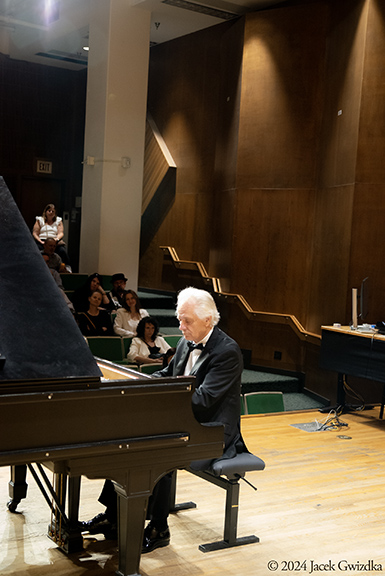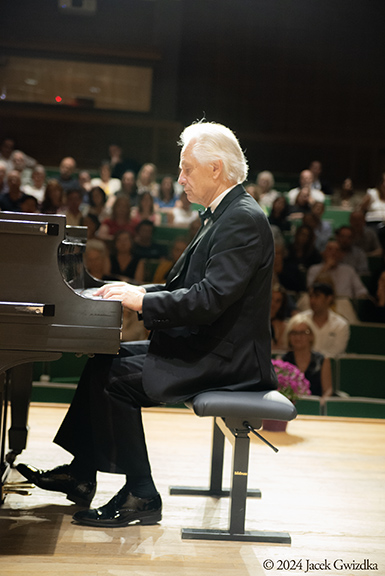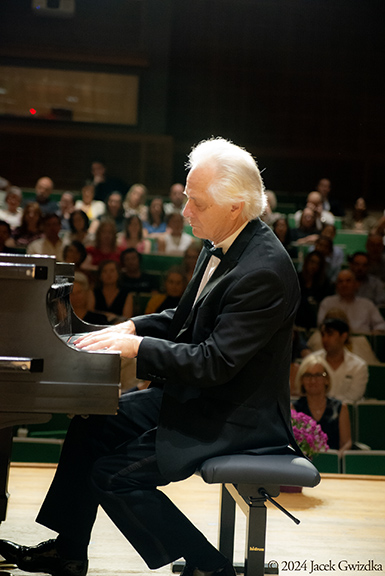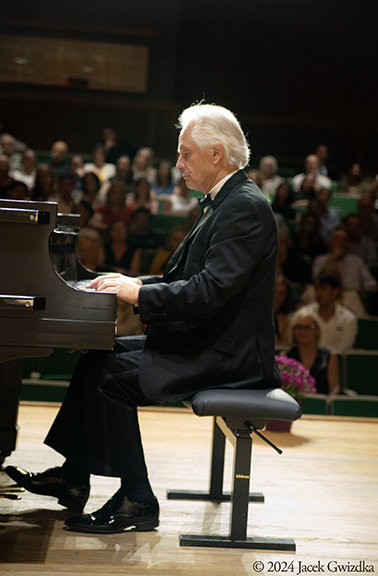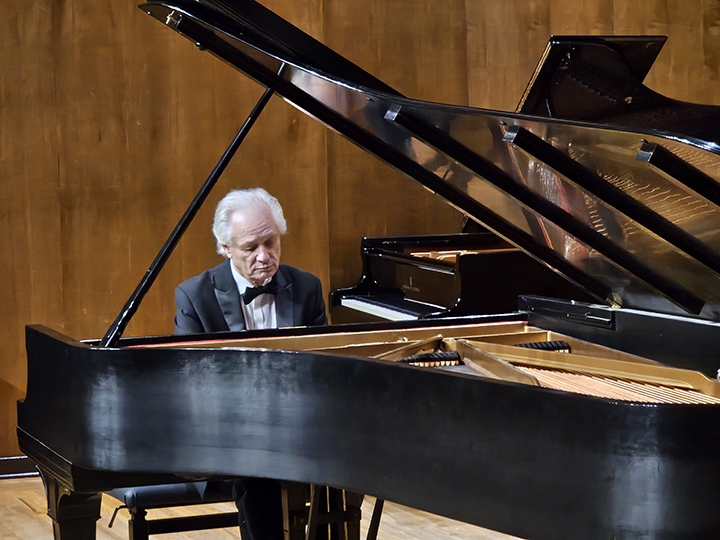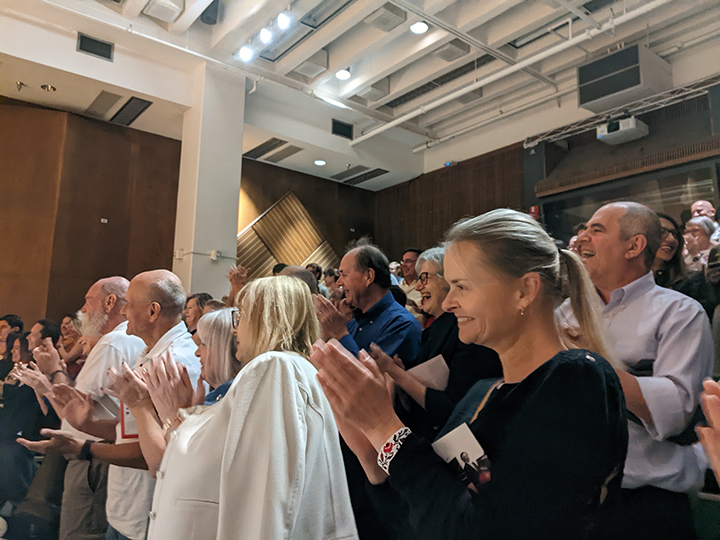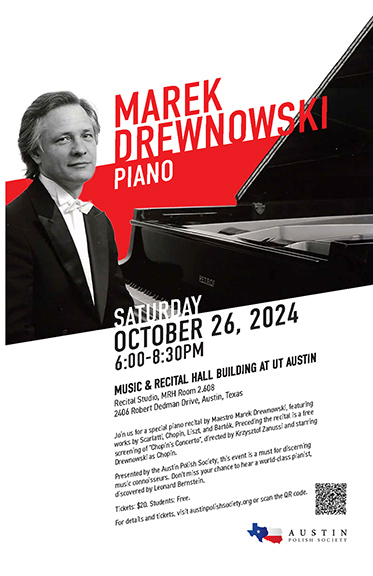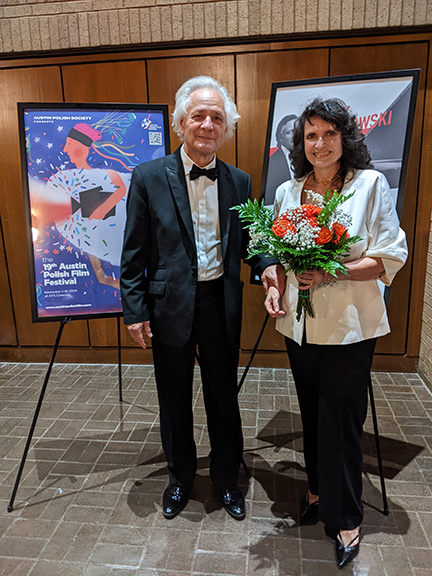Do życia jest potrzebna gitara
Z MIETKIEM JURECKIM, WIELOLETNIM GITARZYSTĄ BASOWYM ZESPOŁU BUDKA SUFLERA – ROZMAWIA MARIA DUSZKA
*
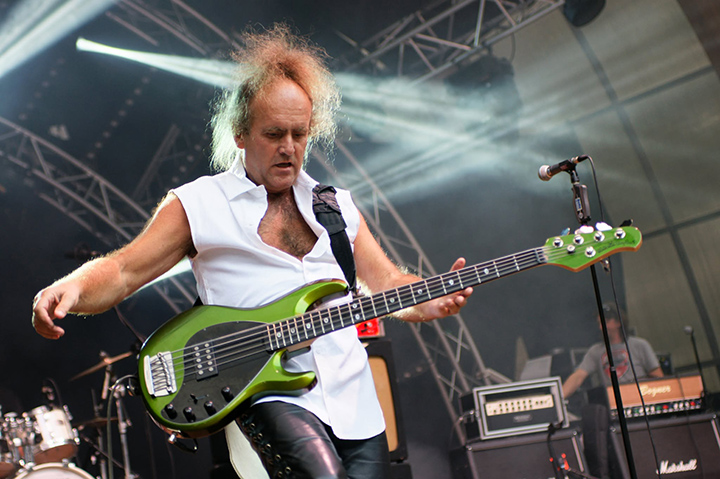
Maria Duszka:
Interesują mnie źródła, początki… Urodził się pan we Wrocławiu, więc domyślam się, że rodzice mieli korzenie kresowe.
Mietek Jurecki:
Oczywiście. Moi rodzice urodzili się na terenie przedwojennej Polski, a w dokumentach kazano im wpisywać, że w ZSRR. Ojciec pochodził spod Stanisławowa, a mama z miejscowości Podhajce. Gdy byliśmy dziećmi, to mama tylko raz nam opowiedziała o przeszłości swojej rodziny, bo te wspomnienia za dużo ją kosztowały. Jako kułakom zabrali im majątek. Mama miała 11 lat, kiedy zmarła jej mama, czyli moja babcia. Tydzień później razem ze swoim ojcem i o dwa lata starszą siostrą została wywieziona na Syberię. Wkrótce potem dziadek zaginął. Odtąd moją mamą opiekowała się jej siostra. Spędziły tam pięć lat. Jestem zdziwiony, że po takim dzieciństwie, po takiej traumie moja mama wyszła za mąż i wychowała czwórkę dzieci. Myślę, że dobrze wychowała.
Czy rodzice byli utalentowani muzycznie?
Od kiedy pamiętam mój ojciec śpiewał w chórze w kościele Bożego Ciała, mieszczącym się naprzeciw Opery Wrocławskiej. Ja i moje rodzeństwo też tam śpiewaliśmy.
W pana biografiach zamieszczonych w Internecie nie ma mowy o szkole muzycznej, jest tylko wrocławskie IX Liceum Ogólnokształcące im. Juliusza Słowackiego przy ul. Piotra Skargi. Czyli samorodny talent? Jak to się stało, że został pan profesjonalnym muzykiem?
Gdy miałem cztery lata, dostałem pod choinkę skrzypce – zabawkę. Pamiętam, że były czerwone w białe ciapki. Każde normalne dziecko chwilę by na tym porzępoliło i rzuciło w kąt. Ja tego nie pamiętam, ale rodzice mówili, że zacząłem grać jakieś melodie usłyszane w radiu. A potem rodzice kupili mi harmonijkę ustną. Moja mama była wychowawczynią w przedszkolu, więc miała cały repertuar dziecięcy opanowany. I ja to wszystko bez najmniejszych trudności umiałem od razu zagrać. A potem wychodziłem na podwórko i bardzo mnie dziwiło, że moi koledzy i koleżanki tego nie potrafili, a to przecież takie proste. Kiedy byłem już w szkole podstawowej, mój ojciec zrobił mi taki statyw, który zakładałem sobie na szyję i grałem równocześnie na harmonijce i gitarze. Z własnej inicjatywy do nóg przyczepiłem sobie janczary, takie dzwonki, jakie koniom zakładają zimą podczas kuligu. Stukałem nogą, grałem na gitarze i harmonijce – albo śpiewałem, na zmianę. I już byłem „one man band” – choć nie znałem jeszcze wtedy takiego określenia. I w ten sposób grałem na akademiach szkolnych. W podstawówce zagrałem pierwszy raz w życiu z zespołem na zabawie sylwestrowej. Bardzo często grywałem też wtedy na weselach. Za pieniądze zarobione na jednym z nich zaprosiłem kiedyś całe podwórko do wesołego miasteczka. Wszyscy bardzo dobrze się bawili, niektórzy aż do… wymiotów. A ja bardzo się cieszyłem, że mogłem im to zafundować. Nie myślałem o jakiejś odpowiedzialności – jak to dziecko.
Mieszkaliśmy przy ulicy Kościuszki, róg Kołłątaja, czyli kilkadziesiąt metrów od Klubu Studenckiego „Pałacyk”. To też miało jakiś wpływ, bo słyszałem od dziecka, że tam coś się dzieje w tym „Pałacyku”. Byłem ciekawy, podchodziłem pod okna – ktoś tam stał z gitarą elektryczną i grał, a mnie to fascynowało.
W późniejszych latach podstawówki założyliśmy z kolegami zespół: akordeon, gitara i tamburyn. I graliśmy piosenki zespołu Breakout. Kupiliśmy cztery głośniki pięciowatowe – to wtedy już było głośno. Najpierw występowaliśmy na akademiach szkolnych, a potem trafiliśmy do Domu Kultury Kolejarza, który mieścił się na pierwszym piętrze Dworca Głównego we Wrocławiu. I tam były już gitary elektryczne. I instruktor, dzięki któremu jestem zawodowym muzykiem. Nazywał się Marian Konieczny; Janek Borysewicz też go dobrze wspomina. Mieliśmy zespół amatorski i pan Marian dał nam nuty przywiezione z NRD. Z bardzo trudną partią gitary basowej. To były czasy, kiedy na tym instrumencie w zespole grał najgorszy muzyk, bo tej gitary nie było słychać, solówek się wtedy nie grało. Ale ta partia była trudna i nasz basista nie mógł jej zagrać. Pan Marian kazał mi spróbować. I powiedział: „To ty będziesz grał na basie”. I życie mi zmarnował (śmiech).
Nie poddawałem się, grałem dalej na gitarze. Tylko jak występowaliśmy na przeglądach, na które nasz dom kultury musiał wystawić ekipę, to grałem na gitarze basowej. A potem już zacząłem wstępować z kolegami z liceum; zawsze grałem ze starszymi od siebie, bo byłem zdolny. Najpierw w pierwszej klasie grałem na bębnach z ludźmi z czwartej klasy. A potem ze starszymi kolegami założyliśmy zespół Ekspres i zrobiliśmy na początku test, jakiej muzyki chcą słuchać młodzi ludzie, którzy będą przychodzić do Domu Kultury Kolejarza. No i oczywiście odpowiadali, że Slade, Deep Purple, The Rolling Stones, węgierski Locomotiv GT. Zebraliśmy te informacje i nauczyliśmy się grać tych wszystkich rzeczy. I wtedy na naszych koncertach bywały dzikie tłumy. Bo graliśmy to, czego ta młodzież chciała słuchać.
Mój ojciec zarabiał dotychczas dość dobrze jako kierownik techniczny we wrocławskich Zakładach Naprawczych Taboru Kolejowego. I nagle ta jego pozycja mistrza świata i jedynego żywiciela rodziny zaczęła się lekko chwiać, ponieważ ja grając w piątek i sobotę na koncertach rockowych, zarabiałem więcej od niego.
Pewnego dnia do Domu Kultury Kolejarz przyszedł Alek Mrożek. To był najważniejszy gitarzysta rockowy we Wrocławiu, muzyk – legenda. Do dzisiaj jestem mu wdzięczny, bo to on mnie zaprosił do zespołu Nurt i dzięki niemu zacząłem grać profesjonalnie. Tylko nieszczęście polegało na tym, że on chciał, żebym grał na basie.
Wtedy po raz pierwszy w życiu pojechałem na kontrakt zagraniczny do NRD. Tam zakochałem się w szesnastoletniej Niemce. Ona była potem u mnie nawet w domu ze swoją matką. Moi rodzice byli przerażeni… ale to wszystko było dawno temu. Podczas koncertów w NRD doszło do nieporozumienia. Niemcy myśleli, że jesteśmy zespołem folklorystycznym. I zorganizowali nam koncert w… ogrodzie zoologicznym. Scena była umiejscowiona pomiędzy olbrzymią klatką z sępami, a wybiegiem dla niedźwiedzi. Jak myśmy rozstawili ten swój sprzęt, to te zwierzęta wpadły w furię. Sęp latał po całej klatce, pióra fruwały, a niedźwiedzie próbowały sforsować bariery i dostać się do muzyków. Niezapomniany koncert!
Uczestniczył pan także w nagraniach piosenek Kabaretu Elita w Polskim Radiu Wrocław. Na przykład „Do serca przytul psa” …
3 października mam urodziny, a następnego dnia miałem koncert z okazji 50-lecia pracy artystycznej, więc zaprosiem Jurka Skoczylasa z Kabaretu Elita po to, żeby zagrać mu tę piosenkę tak, jak powinienem to zrobić pół wieku temu, gdy traktowałem granie na gitarze basowej na zasadzie zawodów sportowych – kto szybszy, ten lepszy.
Mam na koncie parę takich sytuacji, kiedy piosenka jest bardzo ładna, tylko basista zwariował. Na przykład z rumieńcem wstydu zobaczyłem kiedyś w telewizji festiwal w Opolu. Grałem wtedy w Alex Bandzie. No i wychodzi Włodzimierz Korcz, jest krzesełko, lampka, pulpit, nuty, Alicja Majewska śpiewa – wszystko się zgadza. Tylko ja właśnie psuję im tę całą piosenkę. Bo wtedy było modne takie strzelanie na gitarze basowej… To jest historia, tego się nie da zmienić! Skasować tamto, nagrać jeszcze raz – nie da się! Nie powtórzymy festiwalu w Opolu czy Sopocie sprzed lat.
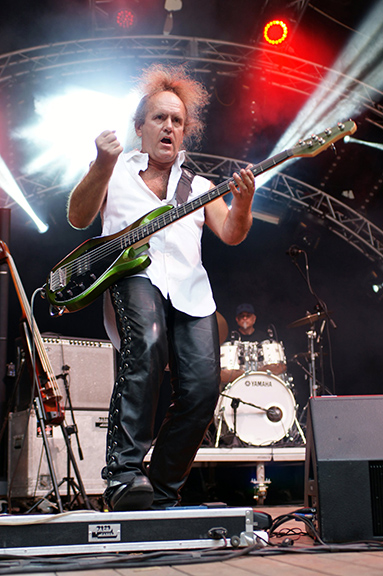
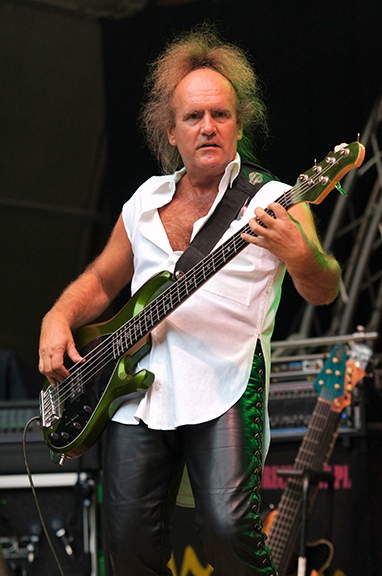
*
Występy z Kabaretem Elita, a granie rockowe, to były chyba dwie różne sprawy…
Ale ja całe życie wolę zagrać dobrze polkę niż słabo rock and rolla. Muzyka jest dobrze wykonywana albo niedobrze. I to jest podstawowa dla mnie różnica. Nieważny jest gatunek. Ja gram to, co mi się podoba, w czym się dobrze czuję.
Niedawno zagrałem koncert z Wojtkiem Klichem. On z Anią Wyszkoni grał przed Markiem Radulim. „Czy ten pan i ta pani są w sobie zakochani?” to jest jego piosenka. Serce całe wkładamy w tę muzykę. Jesteśmy zachwyceni tym, co z siebie wydobywamy, z tych swoich głów, rąk. I ludzie to widzą, że to nie jest oszustwo. Że nikt się nie nudzi. Ja od dawna nie wychodzę na scenę po to, żeby się zastanawiać, czy ja teraz powinienem się uśmiechnąć do ludzi. Zwłaszcza jak z Hołdysem graliśmy w Perfekcie, to myśmy wychodzili na scenę po to, żeby publiczność powalić na kolana. I to się udawało, bo też Zbyszek miał przepiękne piosenki. W każdym razie jestem w tej szczęśliwej sytuacji, że grałem i nagrałem kosmiczne ilości płyt, piosenek, zagrałem ileś tysięcy koncertów, chyba mam wszystkie możliwe do zdobycia nagrody w Polsce – powiem bardzo skromnie.
A pamięta pan swoją pierwszą kompozycję? Kiedy to było?
Zapomniałem o tym, teraz mi pani przypomniała. To było chyba w 1976 r. Mój ojciec usłyszał w radiu, że zapowiedzieli piosenkę skomponowaną przeze mnie, wyciągnął do mnie rękę i pogratulował mi. Nie pamiętam, jaka to była piosenka, ale pamiętam, jak się nazywał realizator: Jerzy Rezler. To postać we Wrocławiu po prostu kultowa. On nagrywał przeglądy tych wszystkich zespołów dziecięcych, w których ja występowałem. A potem nagrał tę moją kompozycję. Na jeden mikrofon – ale Beatlesi też nagrali w ten sposób największe hity. To dzisiaj jest tak, że młody człowiek nie ma prawie niczego do zaproponowania, ale od razu stawia warunki. Na przykład potrzebuję młodego gitarzysty, to on nie pyta, co trzeba zagrać, tylko za ile. Poza tym bez Marshalla to nie zagra. Ja pamiętam z młodości, że wystarczało, jeśli ktoś miał zwykłe domowe radio, takie z głośnikiem i lampką – magicznym okiem okrągłym. Gdybym w ten sposób podchodził, że na razie nie mogę grać, bo nie mam Gibsona i Marshalla, czyli gitary i wzmacniacza światowej klasy, no to bym nigdy nie zagrał nic. W ogóle czasy się zmieniły. Zmieniła się też rola muzyki. Kiedyś o co innego chodziło. Dzisiaj paru gości w garniturach usiłuje piosenkę sprzedać jak worek ziemniaków. I normy są takie, że po ośmiu sekundach musi się zacząć pierwsza zwrotka, a piosenka nie może mieć więcej niż trzy minuty. Gdyby ktoś taki kilkadziesiąt lat temu decydował o twórczości Pink Floyd, Led Zeppelin, to w ogóle całej tej światowej muzyki by nie było.
Dlaczego tak się dzieje? I czy można z tym coś zrobić?
Mogą coś zrobić tylko artyści. Ten lep na muchy, który te koncerny zagraniczne tutaj przywiozły – że „tutaj podpisz papierek i zaraz będziesz gwiazdą”, to jest po prostu chore. Tak samo jak chore są te telewizyjne konkursy typu „talent show”. Że wygrał w konkursie, to już ma wymagania, bo on wie, jak ma być. Bo nasłuchał się tych bzdur. A tu o co innego chodzi.
Na szczęście są jeszcze młodzi, rozsądni ludzie – jest ich nieprawdopodobnie dużo. Ja przez 13 lat organizowałem Festiwal „Solo Życia”. Co roku nagrywałem podkład muzyczny z paroma hakami, aby ci mniej zdolni od razu się na tym przewrócili. Do tego podkładu każdy muzyk z całego świata mógł nagrać solówkę, najlepiej jak potrafi. Dlatego to się nazywało „Solo Życia”. Na początku jeszcze nie było MP3, więc na płytach CD nam nagrania przysyłali. Myśmy tego słuchali i wybieraliśmy najlepszych – od pięciu do ośmiu osób. I oni potem przyjeżdżali. Nie na własny koszt, bo to nie był jakiś oszukańczy festiwal, tylko prawdziwy. Ja nigdy nie podpisywałem umowy na wyłączność, że jestem „właścicielem” jakiegoś człowieka. A tak to się odbywa gdzie indziej. Ci wybrani przez nas grali w finale konkursu na żywo z profesjonalnymi muzykami. I ze mną też. Ktoś wygrywał i potem ja go holowałem po innych festiwalach, na których występowałem. On poznawał branżę i jeśli miał trochę szczęścia, to stawał się jej członkiem. Jeśli to był prawdziwy talent, to wszyscy byli zachwyceni. Ja parę razy dopłaciłem do takiego festiwalu. Bo kiedy taka impreza staje się ogólnopolską i są zgłoszenia nawet z Anglii, to władze danego miasta mówią: „E, on to już da sobie radę, to teraz się zajmijmy czym innym”. Ten mój festiwal miał hasło: ”Lepiej grać niż pić lub ćpać”. To wszystko miało ręce i nogi. Na przykład Jimmy Hendrix, Janis Joplin, czy Rysiek Riedel… Wyobraźmy sobie, jak oni by dzisiaj grali, gdyby nie to, że niestety zainteresowali się czym innym. Zawsze proponuję muzykom, którzy twierdzą, że nie mogą na trzeźwo wyjść na scenę: „Skoro tak uważasz, to dobrze: napij się, zagraj, nagraj to i posłuchaj potem na trzeźwo”. Efekt murowany!
Ma pan za sobą doświadczenia z używkami?
Oj, nie byłem przez całe życie święty. Wręcz przeciwnie! Był taki czas, że byłem bohaterem połowy opowieści o naszej branży. Dzisiaj mogę się tylko rumienić. Wtedy koledzy gratulowali mi takich idiotycznych pomysłów. Ja bym po prostu na trzeźwo nawet na to nie wpadł, ale po pijanemu, to nie dość, że wpadłem, to jeszcze zrobiłem. No katastrofa! Ale na szczęście mam to za sobą. I to już kilkadziesiąt lat… To znaczy, ja już przestałem komukolwiek przysięgać – czy Bogu, czy żonie, czy sobie – że nigdy. Nie ma nigdy! Ja nie wiem jak będzie, natomiast – na razie nie. Mój kolega mi wytłumaczył, jak na początku jakieś próby podejmowałem… Dwa lata zaciśnięte zęby, że nie będę… I tak z żalem mu powiedziałem, że ja już się chyba nigdy normalnie nie napiję. A on mówi: „Wiesz co, a ja nigdy nie będę lotnikiem ani czołgistą”. Dla niego to było tak nieważne, jak bycie czołgistą. Więc zacząłem się zastanawiać dlaczego dla mnie to jest ważne. I w momencie, kiedy się zacząłem zastanawiać, to wszystko puściło. No i już. Oczywiście to wszystko nie jest takie proste, bo to trwało trochę, ale jestem dowodem na to, że jest to możliwe.
Można być rockmanem niepijącym?
Łatwo nie jest. Jak z Hołdysem zacząłem grać… Idziemy gdzieś tam, ja proszę kawę. Zbyszek na to: „No co ty, muzyk rockowy i kawa? Nie rób obciachu!”
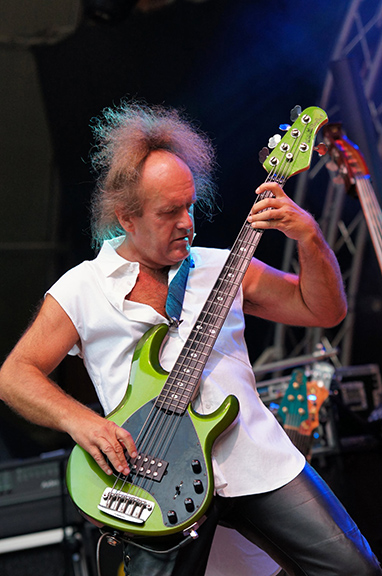
Dlaczego przeprowadził się pan w Wrocławia do Lublina?
Przez 15 lat dojeżdżałem do roboty do Lublina, do Budki Suflera. Tomek Zeliszewski, perkusista Budki Suflera, przeprowadził się z Tarnowa do Lublina w wieku 18 lat. No i on tłucze się już 50 lat w tym zespole. Jako jedyny muzyk nagrał wszystkie płyty z Budką. Ja tam zacząłem grać w 1981 r. Potem Marek Raduli przeprowadził się z Kędzierzyna – Koźla do Lublina. I on mi poradził: „Przeprowadź się do Lublina, będziesz częściej w domu”. Myślę: ”Co on do mnie gada? Jak ja będę częściej w domu, jak dom mam we Wrocławiu?” I dopiero w Ameryce zobaczyłem, że ktoś mieszka na przykład w Nowym Jorku i nagle dostaje pracę w San Francisco. Wystawia przed garaż na sprzedaż wszystkie rzeczy, których chce się pozbyć. Potem bierze jakąś przyczepę, zabiera to, co najbardziej potrzebne i za trzy dni jest tam. I nie robi z tego żadnej tragedii. To tylko u nas jest tak, że chałupa się wali na głowę, ale dziadziu tu mieszkał, to ja też tu muszę. Nic nie muszę. Ja się przeprowadzałem wielokrotnie. Jedna dobra rzecz wynika z przeprowadzek: że nie wlecze się za sobą tego bałaganu, tych wszystkich rzeczy, bez których, jak się okazuje, można żyć. Selekcja następuje.
Mój znajomy o korzeniach wileńskich, profesor łódzkiej ASP Robert Jundo, kiedy się przeprowadzał do nowego domu, to zaprosił przyjaciół do tego starego i poprosił ich, aby brali – co tylko kto chce.
Ja tak samo rozdałem meble. Po co ja mam z sobą taszczyć jakieś rzeczy niepotrzebne. Gitara jest potrzebna do życia. A reszta… Moja żona była w szoku, kiedy zobaczyła, że ja wyjeżdżam z Hołdysem na pół roku do Ameryki i mam w reklamówce: maszynkę do golenia, szczoteczkę do zębów i jakieś tam spodenki… No w razie czego, to przecież sobie kupię. Po co ja mam to nosić z sobą? Parę razy jeździłem na pielgrzymki do Ziemi Świętej. Ludzie z jakimiś walizami… Tak patrzą na mnie i pytają: „A gdzie pan ma bagaż”? A ja pokazuję na tę reklamówkę. Może ktoś musi się przebierać codziennie w coś innego. Ja nie muszę. Ja jestem tak wytresowany, że jak wjeżdżam do hotelu i zdejmuję skarpetki, to od razu je piorę i rzucam na kaloryfer albo na słońce. Na drugi dzień są już suche. Na wszelki wypadek mam jeszcze drugie. No oprócz ciuchów na estradę. Jakieś spodnie na zapas – jak mi pękną, żebym nie chodził w dziurawych. Tak naprawdę do życia bardzo mało rzeczy jest potrzebnych. Szczęście moje między innymi na tym polega, że się nie przywiązuję do czegoś tak na zawsze. Że tak zawsze będzie. Ja nie wiem jak będzie jutro.
Ale to jest chyba typowe dla potomków przesiedleńców z kresów. Ja mieszkam w centrum kraju, ale w latach osiemdziesiątych przebywałam we Wrocławiu. I zauważyłam ze zdziwieniem, że tam często ludzie mówili: „A, nie ma co remontować tych domów, mieszkań, bo nie wiadomo, czy nam ich nie zabiorą”. Mieli w sobie taki lęk, poczucie, że są tutaj chwilowo.
– Ale to nie jest przypadkowe. Bo ci ludzie, którzy tam mieszkali, to zostali wywiezieni ze swoich domów, tak jak i moi rodzice. Więc do czego oni mieli się przyzwyczajać? Do jakiegoś poniemieckiego domu?
Nie jest pan materialistą?
Ludziom się we łbach przewraca, mają wymagania. To dotyczy muzyków, że bez super sprzętu nie zagra. To samo dotyczy warunków życia. No bo jak to? Auto bez klimy? A kiedyś nie było klimy. Kiedyś był mały fiat, w którym trzeba było siedzieć krzywo, żeby utrzymać kierownicę. I ja byłem szczęśliwy, że jadę.
Motorem działań wielu ludzi jest brak wyobraźni i pieniądze. Można tam jeszcze parę rzeczy znaleźć, ale to jest podstawa. Brak wyobraźni, bo jak ktoś ma auto, to chce mieć helikopter. Potem chce mieć rakietę, statek i cały czas jest mu mało. A potem to już chce mieć władzę nad światem. Ma tylko jeden problem, czyli… nieśmiertelność. Prędzej czy później się okazuje, że trumna nie ma kieszeni i nie ma gdzie schować tego, co gość nazbierał przez całe życie. I nagle to nie ma wartości takiej, jakby się wydawało. Bo potem jest „panu już dziękujemy” i „kawalerka w Zakopanem”.
Kawalerka metr na dwa.
Przecież mnie wielokrotnie było stać na różnego rodzaju fanaberie. Dwa razy w życiu taką fanaberię sobie spełniłem. Jedna dotyczyła muzyki. No chyba mam najdroższe gitary basowe, jakie są w Polsce. Chciałem kupić gitarę, na której gra jeden z moich „bogów”, czyli Stanley Clarke z zespołu Return to Forever. Chciałem ją mieć tak z ciekawości – chociaż od dawna wiem, że nie zagram na niej lepiej, bo albo się coś umie albo nie. Czy ktoś będzie kopał łopatą stalową, srebrną czy złotą, to przecież ma tylko takie znaczenie, że droższe są mniej trwałe. Jechałem do Ameryki i już nie wziąłem ze sobą gitary, bo nowa czekała na mnie w Chicago. Cała obsługa sklepu się zbiegła, żeby zobaczyć, że jakiś szmaciarz z Polski sobie coś takiego kupuje. I wziąłem ją, i zagrałem. I myślę: „To przecież w domu ja mam lepszą gitarę”. Ale już… chciałem, to mam. Doceniłem ją dopiero w studiu, jak zagrałem i tak już zostało do końca – nikt niczym nie kręcił, nie kombinował. No to jednak jest różnica.
No i druga fanaberia to auto. Ja raz w życiu kupiłem nowe auto w salonie. Nigdy więcej nie kupię. Zwłaszcza przy droższych samochodach, to wiadomo, że nawet jak się coś zepsuje, to tego właściciela będzie stać na naprawę. W każdym razie nówka ze sklepu jest przereklamowana. Nigdy więcej! Ferrari też jechałem. Mocno przekroczyliśmy prędkość na obwodnicy Tarnowa. Jak potem zwolniliśmy, to nas złapała policja. A potem staliśmy na czerwonym świetle, jak wszyscy. Albo na przejeździe kolejowym. To pije strasznie benzynę i hałas jest w środku. No i oczywiście tam się nie da już gitary włożyć, bo nie ma gdzie. No gitarę może od biedy tak, ale wzmacniacza już na pewno nie. No i fajnie wygląda. Ale gdzie ja miałbym tym pojechać? I gdzie to zaparkować na ulicy? Zaraz będzie płacz, bo ktoś gwoździem przejedzie. A co druga osoba, to będzie chciała wejść do środka i sobie zdjęcie zrobić. Po co? Znam paru właścicieli drogich samochodów. Te wszystkie nowości i te drogie rzeczy są przereklamowane.
A tak à propos techniki… Skąd ksywa Mechanik?
A to Bogdan Olewicz wymyślił. Dawno temu – jak sam grałem i śpiewałem. Zresztą do dzisiaj grywam takie koncerty. I on mówi: „No, są różne zawody. Jest hydraulik, jest szlifierz, ślusarz… A taki co umie wszystko zrobić, to mechanik. A ty grasz na wszystkich instrumentach – no to mechanik”. No to takie średnio dowcipne, ale wtedy patrzyłem na niego jak na Pana Boga. Bo to przecież facet, który napisał „Nie płacz Ewka”, „Niewiele ci mogę dać” i „Autobiografię”… Ale nie brałem pod uwagę, że jak z nim zaczęliśmy pisać piosenki, to ja w międzyczasie nagrałem jakieś Jolki, dmuchawce i inne rzeczy. I też coś tam wiem na temat muzyki. A to może kwestia wychowania, bo Bogdan jest starszy ode mnie, a ja z domu wyniosłem szacunek dla starszych. Często do mnie ludzie starsi mówią na „ty”. No to trudno mi do nich inaczej się zwracać niż „proszę pana”. No ale to z wiekiem przechodzi. A też już coraz trudniej znaleźć starszego od siebie.
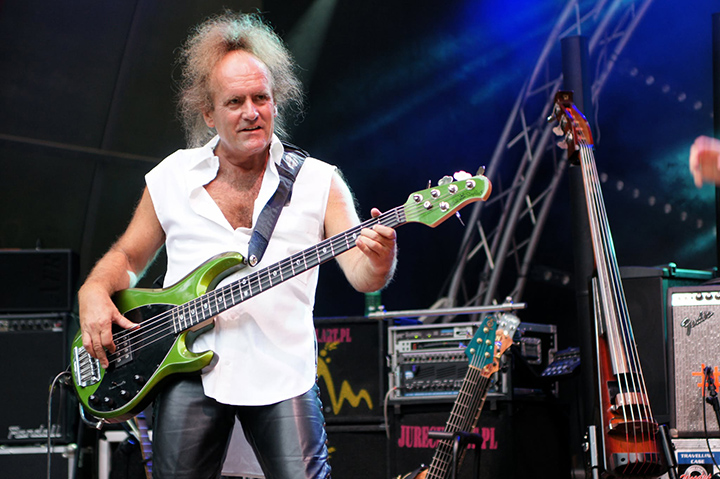
Jak rodzina znosi pana tryb życia? Żona od początku ta sama?
Żona ta sama – od 42 lat. Trzy córki. Na szczęście moja żona ma świra na punkcie swojej pracy, takiego jak ja na punkcie swojej, więc się rozumiemy. Jest psychoterapeutką. Ona wychodzi rano, wraca w nocy, bo mówi, że musi ludziom pomagać. Jak byliśmy 8 lat po ślubie, to żona mi wyliczyła, że przez ten czas 2 lata byłem w domu, więc 6 byłem poza. Ale to jest też przyczyna, dla której się nie rozwiedliśmy. Przychodzę do domu i mówię sobie: „O, nawet dość atrakcyjna kobitka!” A jak ma się coś zadymić, to ja właśnie wyjeżdżam. I nie ma kiedy się tak naprawdę pożreć.
A córki odziedziczyły po panu talent muzyczny?
To bardzo możliwe, ale… jak były małe, to w pokoiku dziecięcym leżał miś, lala, gitarka i jakiś klawisz. Na szczęście tej gitarki i klawisza za często nie brały do ręki.
Nie chciały iść w pana ślady?
Z daleka to ten zawód wygląda przepięknie: grają, śpiewają, dymy, stroboskopy, autografy, cuda… I jeszcze im za to płacą czasem. Ja wiem, po co wychodzę na scenę. I wiem, jakie są oczekiwania. Nikogo nie interesuje, że na przykład boli mnie brzuch. Tylko mam być zachwycony, że po raz tysięczny wykonuję tę samą piosenkę. I jestem zachwycony, naprawdę. Kilka lat temu graliśmy na Przystanku Woodstock. Na widowni 700 tysięcy. Patrzę, a po horyzont tych ludzi. I to sami młodociani, których nie było na świecie, jak myśmy „Jolkę” nagrali w 1982 r. I te dzieci śpiewały z nami, każde słowo znały. I tak sobie wtedy pomyślałem, że chyba nie całkiem zmarnowałem to życie. I w momencie, kiedy będzie końcówka, a już parę razy ocierka była, to ja na pewno nie będę prosił o jeszcze dwie godziny. Zdaję sobie sprawę z tego, że przeżyłem tyle, że wystarczy na parę życiorysów.
Raz lecieliśmy z Chicago do Phoenix, międzylądowanie było w Denver. No i nad tym Denver nagle turbulencje takie, że samolot spada po kilka metrów, podnosi się i znowu spada. Faceci krzyczą, kobiety wymiotują, a ja tak przypięty tym pasem myślę: „Acha, to już? Szkoda, bo jeszcze chciałem zrobić to i to”. I wylądowaliśmy. A potem się okazało, że tam tak jest zawsze, tylko nikt nam nie powiedział. A już myślałem, że właśnie: „Panu już dziękujemy”. Parę takich sytuacji przeżyłem. Ja uważam, że jestem szczęśliwym, spełnionym człowiekiem, co rzadko kto pewnie mówi.
Choć jak patrzę z pespektywy czasu, to oczywiście wiele rzeczy bym zmienił w swoim życiu. Na szczęście tego zmienić się nie da. To tylko na filmach tak jest. Że ktoś tam naciśnie jakiś guzik albo pięści zaciska i już się przenosi w czasie, i poprawia sobie to, co mu nie wyszło. To się tak nie da. Bo życie z ideałami pewnie jest nie do wytrzymania.
Trudno pewnie wybrać, ale którą ze swoich piosenek uważa pan za swój największy przebój, albo którą najbardziej lubi.
Ja swoich piosenek nagrałem kilkaset, a skomponowałem tysiące. Ale jedna z tych piosenek odniosła wielki sukces, ponieważ przez 12 lat była wykorzystywana w serialu „M jak miłość”. Wojtek Gąsowski ją śpiewał. To właśnie moja piosenka do tekstu Bogdana Olewicza. To jest akurat sukces bardziej finansowy niż muzyczny. Bo żądanie było, żeby nie była zbyt przebojowa, żeby nie odwracać uwagi od akcji.
Każdy muzyk powie pani, że najlepsze to dopiero nagra. Ja też. Za chwileczkę wychodzi moja kolejna solowa płyta. Na razie dostępna w Internecie – jestem z niej bardzo dumny. Płyta „Kołowrotek” z tekstami Staszka Głowacza. Jest w tych piosenkach trochę o mnie, bo ja Staszkowi opowiadałem o swoim życiu, o rodzicach. Ile oni musieli się ze mną namęczyć! Bo tu Budka Suflera, gorzała, dziewczyny, high life – no żyć, nie umierać. Któregoś dnia ojciec zaproponował, że załatwi mi pracę w Zakładach Naprawczych Taboru Kolejowego, bo to granie, to takie niepewne zajęcie. ZNTK już dawno nie istnieje, a ja gram dalej. Przyznaję – to był okres, kiedy trochę im krzywdy zrobiłem. Inna sprawa, że rodzice mieli zupełnie inne oczekiwania. Ja tak naprawdę na studia poszedłem dla nich. Choć nie chciałem dalej się uczyć, bo już grałem zawodowo. Wybrałem Akademię Ekonomiczną we Wrocławiu dlatego, że tam był Klub Studencki Simpleks, w którym mieliśmy próby.
I skończył pan te studia?
A skądże! Do wyboru miałem po pierwszym semestrze albo zdawanie egzaminów, albo trasę koncertową z zespołem jazzowym. Wiadomo, że pojechałem na koncerty. Choć wiedziałem, że mam jeszcze do zaliczenia egzamin z języka rosyjskiego. Kiedy powiedziałem w dziekanacie prawdę, że byłem w trasie koncertowej, to usłyszałem, że tylko zaświadczenie lekarskie się liczy. I oddano mi papiery. No, rodziców to kosztowało troszkę, bo sobie wyobrażali, że ich zdolny syn… To prawda, byłem zdolny. Chodziłem w liceum do klasy matematyczno – fizycznej. Te wszystkie techniczne rzeczy, to do dzisiaj mnie fascynują. Jak cokolwiek w domu przestanie działać, to rodzina czeka, aż ja przyjadę. Jeśli jestem, to od razu naprawiam – komputer i nie tylko. Teraz młodzi, jak im się wyłączy prąd, to nie wiedzą nic. Ja wiem, że mech rośnie po północnej stronie drzewa i zawsze gdzieś dojdę. A oni już niekoniecznie.
Na koniec zapytam jeszcze o tę oryginalną, jedyną w swoim rodzaju fryzurę…
A mieliśmy kiedyś koncert, był upalny dzień, związałem włosy gumką i… tak już zostało.
Bardzo dziękuję za rozmowę. Nawet nie musiałam zadawać dużo pytań. Miło mi się słuchało.
Ja tak mam… Czasem redaktor nie zdąży nawet zadać pierwszego pytania. Staram się opanowywać. (śmiech)
Wywiad zosta przeprowadzony we wrześniu 2024 r.
Zobacz też:
